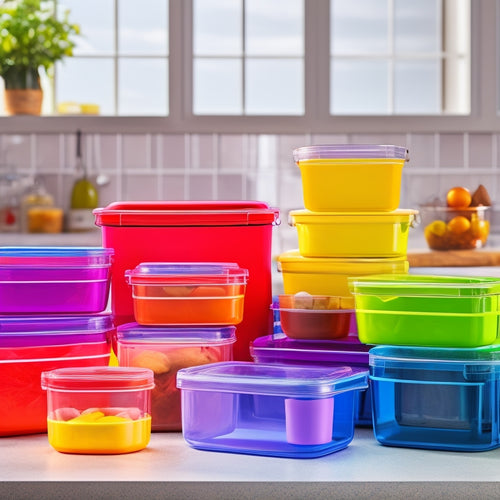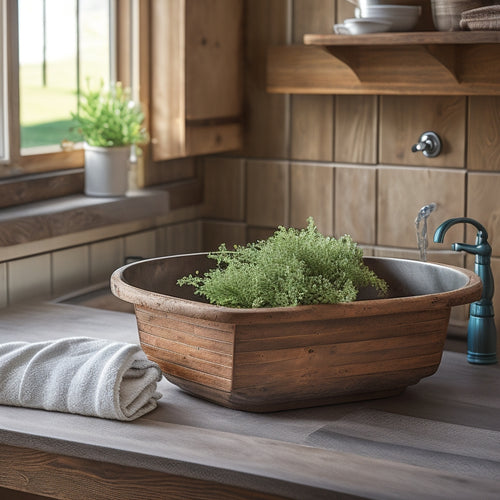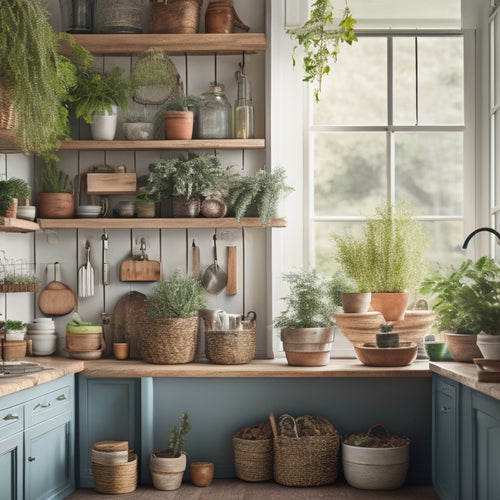
Create a Functional Kitchen With Proven Strategies
Share
You're about to transform your kitchen into a haven of efficiency, where every tool, ingredient, and movement is meticulously optimized to make cooking and entertaining a breeze. Start by identifying what's not working and setting specific goals to address your unique pain points. Assess your kitchen's layout, examining functionality and traffic flow to identify bottlenecks. Then, maximize storage space with dividers, baskets, and hooks, and optimize your workflow by implementing the 'work triangle' concept. By prioritizing functional and visually appealing solutions, you'll create a kitchen that's both beautiful and functional. Now, take the next step towards your kitchen's full potential.
Key Takeaways
• Identify current kitchen challenges and set specific, achievable goals for a functional kitchen.
• Assess the kitchen's layout to optimize functionality, traffic flow, and the 'work triangle' concept.
• Maximize storage space efficiently with dividers, baskets, racks, and hooks, keeping it visually appealing.
• Optimize workflow and traffic by analyzing kitchen routines, appliance placement, and designating a 'landing strip'.
• Select essential storage solutions that are functional, visually appealing, and tailored to specific kitchen needs.
Setting Kitchen Organization Goals
To create a functional kitchen, start by identifying what's not working for you and set specific, achievable organization goals that address your unique pain points and priorities.
Are you tired of cluttered countertops and wasted time searching for utensils? Do you struggle to prep healthy meals for your family? By pinpointing your challenges, you can create a tailored plan to overcome them.
Begin by decluttering essentials like redundant kitchen gadgets and expired ingredients. Invest in functional kitchen tools, such as a utensil organizer or a set of stackable containers, to maximize storage and efficiency.
Next, consider setting up zones for different tasks, like a cooking zone with a prep station and a cleaning zone with a sink and trash can. This will help you move seamlessly through meal prep strategies, like chopping veggies or marinating meats.
Assessing Your Kitchen's Layout
Now that you've set your organization goals, take a closer look at your kitchen's layout to identify any obstacles or opportunities that might impact your workflow. Examining functionality and traffic flow is essential in creating a smooth and efficient kitchen environment.
Walk through your kitchen, imagining yourself preparing a meal, and take note of any bottlenecks or areas that cause frustration. Recognizing layout challenges is the first step in finding solutions. Do you find yourself constantly walking around the island to get to the sink? Is the distance between the stove and refrigerator too far? Are there any blind spots or corners that make it difficult to navigate?
Take note of these challenges and think about how you can reconfigure the space to improve traffic flow. Consider the 'work triangle' concept, where the sink, stove, and refrigerator form the points of a triangle, allowing you to move easily between tasks.
Maximizing Storage Space Efficiently
Your kitchen's storage space is a valuable commodity, and maximizing it efficiently is essential to maintaining a clutter-free and organized cooking environment. To make the most of your storage space, start by optimizing your drawers with dividers that separate utensils, cookware, and dinnerware. This will prevent clutter from building up and make it easier to find what you need when you need it.
Next, turn your attention to your pantry. Use baskets to store dry goods, snacks, and spices, keeping them organized and easily accessible. Consider installing over the door racks to hang items like pots, pans, and kitchen utensils, freeing up valuable cabinet space. Under cabinet hooks can also be used to hang items like tea towels, oven mitts, and even a trash bag holder.
Optimizing Workflow and Traffic
By analyzing your daily kitchen routine, you can identify areas where workflow and traffic bottlenecks occur, and make targeted changes to optimize the flow of your kitchen. A well-designed kitchen layout can significantly improve task efficiency, allowing you to move seamlessly from one task to another.
Consider the 'work triangle' concept, where your sink, stove, and refrigerator form the points of a triangle, minimizing walking distances and improving traffic flow.
When designing your workspace, think about the tasks you perform most frequently and place appliances and utensils accordingly. For instance, if you bake often, position your stand mixer and baking supplies near the counter where you'll be working. This strategic appliance placement will save you time and energy in the long run.
Additionally, consider the 'landing strip' concept, where you designate a specific area near the entrance of your kitchen as a drop zone for groceries, mail, and other items, keeping clutter at bay and maintaining a smooth traffic flow.
Selecting Essential Storage Solutions
In a kitchen where every inch counts, clever storage solutions can make all the difference between a cluttered, stressful space and a serene, efficient one. By selecting the right storage solutions, you can create a kitchen that's both functional and visually appealing.
Start by optimizing your drawers with dividers that separate utensils, cookware, and dinnerware, keeping them organized and within easy reach. Cabinet inserts can also help maximize vertical storage, keeping items like plates, glasses, and cookbooks neatly stacked and accessible.
Don't forget about your pantry – a well-organized pantry can be a game-changer. Install shelves, baskets, or bins to store dry goods, spices, and other essentials, making meal prep a breeze. Spice racks are another must-have, keeping your favorite seasonings at your fingertips.
With these essential storage solutions in place, you'll be able to focus on what matters most – cooking up a storm and serving delicious meals to your loved ones. By streamlining your kitchen's storage, you'll create a more efficient, enjoyable cooking experience that will leave you feeling proud and accomplished.
Implementing a Maintenance Routine
Now that you've optimized your kitchen's storage, it's time to establish a routine that'll keep your space organized, clean, and running smoothly.
To maintain your kitchen's functionality, you need to prevent clutter buildup. Set aside 10-15 minutes daily to quickly tidy up and put away items after use. This consistent cleaning schedule will guarantee your kitchen remains clutter-free and hygienic.
Regular maintenance checks are also vital in avoiding appliance malfunctions. Schedule monthly checks to inspect and clean your appliances, including the oven, refrigerator, and dishwasher. This proactive approach will prevent breakdowns, reduce repair costs, and extend their lifespan.
Additionally, perform routine tasks like replacing air filters, cleaning exhaust fans, and lubricating hinges to keep your kitchen running efficiently.
Creating a Personalized System
You'll maximize your kitchen's functionality by tailoring a system that caters to your unique cooking style, preferences, and habits. This means creating a space that's tailored to your needs, making cooking and entertaining a breeze.
By customizing storage and personalizing the layout, you'll be able to move efficiently and focus on what matters – serving delicious meals to your loved ones.
Here are some strategies to help you create a personalized system:
-
Customize storage: Assign a home for each item, making sure frequently used utensils and ingredients are easily accessible.
-
Personalize the layout: Position your most-used appliances and workstations in a way that minimizes walking distances and maximizes workflow.
-
Label and categorize: Use labels and categories to keep similar items together, making it easy to find what you need when you need it.
-
Designate zones: Create distinct zones for cooking, prep, and cleaning to maintain a sense of order and calm.
-
Make it flexible: Leave some space for flexibility, allowing you to adapt to new recipes, ingredients, or cooking techniques.
Frequently Asked Questions
How Do I Balance Aesthetics With Functionality in My Kitchen Design?
"You're not alone in wanting a kitchen that's a million times more beautiful than functional! To strike a balance, you'll love incorporating aesthetic trends like mixed metallics with space-saving solutions like nesting tables to create a harmonious haven that serves both style and substance."
Can I Still Have a Functional Kitchen With a Small Budget?
You can absolutely have a functional kitchen on a small budget! Focus on budget-friendly organization, maximizing space with DIY solutions and creative alternatives that don't break the bank, so you can serve others with ease and style.
Are Custom Storage Solutions Worth the Extra Investment?
You're wondering if custom storage solutions are worth the extra investment. While they optimize space and organization, they can be pricey. Consider budget-friendly alternatives like adjustable shelves or repurposed furniture to achieve a similar look without breaking the bank.
How Often Should I Reorganize and Update My Kitchen Storage?
As you stand amidst the chaos, imagine a kitchen that's a symphony of efficiency! You should reorganize and update your storage every 3-6 months, incorporating seasonal decluttering, efficient layouts, maximizing vertical space, and rotating inventory to maintain harmony.
Can a Functional Kitchen Be Achieved in a Rental Property?
You can still achieve a functional kitchen in a rental property by implementing temporary improvements that work around the renters' dilemma. Get creative with limited space by using multi-functional furniture and clever storage solutions that don't require major renovations.
Related Posts
-

Stackable Kitchen Containers for Modular Systems
Stackable kitchen containers for modular systems change your cooking space by maximizing vertical storage and enhanci...
-

Sink Caddy Organizers for Farmhouse Style Kitchens
Sink caddy organizers are perfect for elevating your farmhouse-style kitchen while keeping it functional. You'll love...
-

Countertop Storage Ideas for Small Kitchens
If you're looking to maximize your small kitchen, creative countertop storage solutions can make a big difference. Em...


